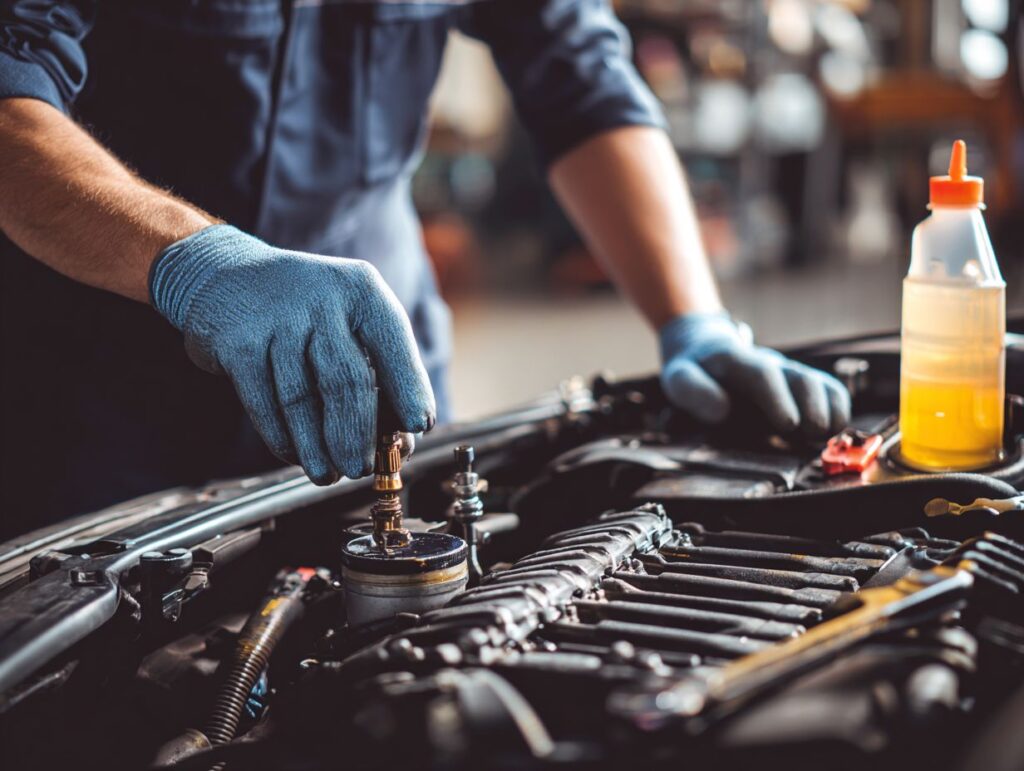Experiencing issues with your power steering can be alarming, especially when you notice unusual noises or difficulty turning the steering wheel. Spotting steering issues early is important for keeping your vehicle safe and running well. This guide will help you identify common signs, like fluid leaks, that indicate issues within your steering system. Trust 55CarGarage, Dubai’s premium destination for luxury car repair, for expert diagnostic services and advanced equipment to effectively resolve your power steering troubles.
Key Takeaways:
Common Symptoms of Power Steering Issues

Knowing the usual signs of power steering problems is important for keeping control of your vehicle and staying safe on the road.
These symptoms often point to mechanical failures. If you’re experiencing strange vibrations, it could be related to various components of your vehicle. Learn more about identifying whether it’s your suspension, transmission, or engine and address the issue promptly.
Unusual Noises When Steering
If you hear whining or groaning noises when turning the steering wheel, this may signal low power steering fluid or a failing power steering pump, potentially compromising driving safety.
Checking the power steering fluid level should be your first step; if it’s low, topping it off can resolve the issue.
Use a clean funnel and the recommended fluid type, typically found in your owner’s manual. If the noise persists after refilling, inspect for leaks or consider testing the pump pressure. Sounds like grinding or clunking can indicate a malfunctioning rack and pinion or worn-out components, which often require professional assessment.
Solving these issues quickly can stop more harm and keep your car safe to drive.
Difficulty in Steering
Having trouble turning the steering wheel or finding it hard to steer can mean there are problems with the steering parts, which affects how you control the vehicle and its safety.
- Start by checking the steering fluid reservoir for low levels; if it’s low, refill it with the appropriate fluid specified in your vehicle manual.
- Next, inspect for worn-out components, such as tie rods or the steering rack, which may require professional diagnosis and replacement.
- Air trapped in the hydraulic system can worsen handling; you can try bleeding the system by turning the steering wheel fully from side to side and topping up the fluid as needed.
- Each of these steps can help identify and resolve the underlying issues.
Fluid Leaks Under the Vehicle
Seeing liquid marks under your car might mean there’s a leak in the power steering fluid. If not fixed quickly, this can make steering harder and raise the chance of accidents.
- To identify a power steering fluid leak, check for a reddish-brown fluid with a thin, oily consistency.
- Examine the area around the power steering pump, hoses, and the steering rack for any traces.
Utilizing a flashlight can help reveal hidden leaks. If you see any liquid, it’s important to deal with it right away. Ignoring it can cause major steering issues and costly fixes.
Regularly monitoring fluid levels in the reservoir can also prevent larger mechanical failures down the road.
What Do These Symptoms Indicate?
Knowing the symptoms of power steering problems helps you act quickly and avoid expensive repairs later.
Common signs include difficulty in turning the wheel, unusual noises such as whining or screeching, and a warning light on the dashboard.
These symptoms may signify low power steering fluid, a failing pump, or issues with the steering rack. Regularly check fluid levels and inspect for leaks.
If you hear noises during turns, it may indicate pump failure requiring immediate attention. Addressing these symptoms early can prevent further damage, prolonging the lifespan of your vehicle’s steering system.
Identifying Fluid Levels and Quality
The right amount and condition of the fluid are essential for the power steering system to work well, affecting how the steering feels and the car’s stability. To ensure optimal performance, understanding other factors like vibrations can be crucial-our guide on strange vibrations provides valuable insights.
Checking Power Steering Fluid Levels

To check the power steering fluid levels, find the reservoir, which usually has a label, and make sure the fluid is at the ‘full’ line. Low levels can cause steering problems.
- Start by cleaning the dipstick, then put it back in to check the level correctly.
- If the fluid is below the ‘full’ mark, carefully add the appropriate type of power steering fluid-usually Dexron or Mercon, depending on your vehicle.
- It’s wise to inspect this every month or after driving 3,000 miles, particularly before long trips, to maintain steering properly.
- Watch for any signs of leaks or smells, which could indicate a more serious issue that warrants professional inspection.
Assessing Fluid Condition and Contamination
Evaluating the condition of power steering fluid involves checking its color and consistency; dark, contaminated fluid may indicate a need for replacement to prevent damage to steering components.
Plus color, look for signs of contamination, such as dirt particles or a burnt odor.
It’s important to regularly check your vehicle. Replace the power steering fluid every 30,000 miles, or follow the instructions in your vehicle’s manual.
If the fluid appears milky or foamy, it may indicate water contamination, necessitating immediate replacement.
It’s wise to check your steering system during scheduled maintenance to keep it working well and safely.
How Can Fluid Issues Affect Steering Performance?
Issues with the fluid, such as leaks or contamination, can greatly impact steering performance, leading to slower response and possibly dangerous driving conditions.
When the hydraulic fluid level is low, the steering system struggles to maintain pressure, which can cause the steering wheel to feel stiff or unresponsive, particularly at low speeds or during tight maneuvers.
Contaminated fluid may introduce air bubbles or particles, further diminishing the system’s efficiency. When a driver doesn’t have enough fluid in their vehicle, they may struggle with tight turns, increasing the risk of accidents.
Regularly inspecting fluid levels and replacing them according to the maker’s instructions can improve vehicle safety and handling.
The Function of the Power Steering Pump
The power steering pump changes mechanical energy into hydraulic energy, which makes steering easier and gives better control of the vehicle.
Signs of a Failing Power Steering Pump
Common signs of a failing power steering pump include whining noises, difficulty steering, and fluid leaks, which can indicate serious problems that require immediate attention.
If you notice these symptoms, act quickly.
- First, inspect the power steering fluid level; low fluid can cause noise and steering issues. Consider using tools like a flashlight for a thorough check.
- If fluid levels are adequate but you hear whining, it may indicate a failing pump that requires replacement-consult a mechanic immediately.
- For fluid leaks, locate the source-often, it’s a damaged hose or connection-which needs repair to prevent further damage. Regular maintenance checks can also help in early detection of such issues.
How to Test Pump Functionality
To test the power steering pump functionality, start the vehicle and observe the steering response while turning the wheel; any lag or unusual noises may indicate pump failure.
For a thorough evaluation, gather the following tools:
- a pressure gauge to measure hydraulic pressure,
- a basin to catch any fluid,
- and safety gloves.
Begin by checking the fluid level; low fluid could mislead you about the pump’s condition.
Next, attach the pressure gauge to the pump output and turn the steering wheel fully left and right. The pressure should typically range from 800-1,200 psi.
Pay attention to any noise changes or fluid leaks, which can signal pump issues. Make sure the engine is not hot and be careful to prevent burns while working.
What Are the Consequences of Ignoring Pump Problems?

Not addressing issues with the power steering pump can result in serious outcomes, such as complete steering failure, increasing the risk of accidents and putting driver safety at risk.
Neglecting these issues can escalate repair costs significantly. For instance, a minor fluid leak could result in a damaged pump, requiring replacement at $500-$700 instead of a simple seal repair costing under $100.
Steering failure can cause crashes, leading to medical bills, insurance hikes, and legal repercussions.
To prevent such outcomes, regularly inspect fluid levels and listen for unusual noises. If you notice steering stiffness, attend to it immediately to mitigate further damage and maintain a safe driving experience.
Importance of Professional Diagnosis
Getting a professional diagnosis is important for correctly finding and fixing steering system problems. Without professional help, important issues that impact the safety of the vehicle can be missed. For instance, did you know that improper wheel alignment can significantly affect steering performance? Curious about how wheel alignment services can enhance vehicle safety? Our detailed guide explains everything you need to know.
Tools for Accurate Assessment
Mechanics use tools such as steering diagnostic devices and pressure gauges to accurately examine power steering systems and identify any concealed issues.
A widely used diagnostic tool is the Autel MaxiSys, which provides detailed checks for vehicles, including evaluations of power steering systems.
With this equipment, mechanics can measure liquid pressure and check steering support functions. For example, a pressure gauge allows them to check fluid levels and identify leaks, while oscilloscopes can help diagnose electrical issues in the power steering system.
When mechanics use these tools correctly, they can make accurate assessments, which increase both the safety and performance of vehicles.
Skill in Finding Basic Problems
Experienced technicians can spot small signs of steering problems that most drivers might miss, providing thorough repairs and maintenance.
Their skill enables them to find problems like wheels that are not aligned correctly or suspension parts that are worn out, which can affect the safety and performance of the vehicle.
For example, a technician might use tools like a wheel alignment machine to measure angles and find any issues. They also draw on their training to recognize symptoms, such as unusual tire wear patterns or steering wheel vibrations, providing a thorough diagnosis.
This specific information helps drivers save time and money by solving issues early.
Why Choose 55CarGarage for Power Steering Repairs?
55CarGarage in Dubai provides repair services for power steering systems, using modern equipment and experienced technicians to fix steering issues successfully.
They know a lot about high-end cars and make sure every repair is done correctly. For example, they use advanced diagnostic tools like the Bosch KTS system, which offers a detailed examination of steering problems.
Clients appreciate the way they offer personalized service. It begins with a thorough conversation to understand each person’s needs and likes. 55CarGarage is dedicated to excellent service, ensuring each repair solves the issue and enhances your vehicle’s performance and safety. For those interested in comprehensive vehicle maintenance, our corporate fleet maintenance services ensure your cars are always in top condition.
Frequently Asked Questions
What are the early warning signs of power steering problems?
 Some early warning signs of power steering problems include difficulty turning the steering wheel, groaning or whining noises when turning, and a stiff or unresponsive steering wheel.
Some early warning signs of power steering problems include difficulty turning the steering wheel, groaning or whining noises when turning, and a stiff or unresponsive steering wheel.
How can I diagnose power steering problems at home?
You can diagnose power steering problems at home by checking the power steering fluid level, inspecting the power steering belt for wear or damage, and checking for any leaks in the power steering system.
Is it safe to drive with a power steering problem?
Driving with a power steering issue is not safe because it can cause you to lose control of the car. It is best to have the problem diagnosed and repaired as soon as possible.
What should I do if I notice my power steering is not functioning properly?
If you notice any issues with your power steering, it is important to stop driving and have it checked by a professional. Continued driving can cause further damage and increase the cost of repairs.
Can power steering problems be fixed without professional help?
It is not recommended to try and fix power steering problems without professional help. Repairing this needs special tools and skills. Trying to fix it yourself might make things worse and could be dangerous.
How can 55CarGarage help with power steering problems?
55CarGarage in Dubai is the top place for fixing high-end cars and has the right tools and knowledge to identify and fix power steering issues. Our team is very good at fixing this problem and can make sure your car is safe to drive again.







